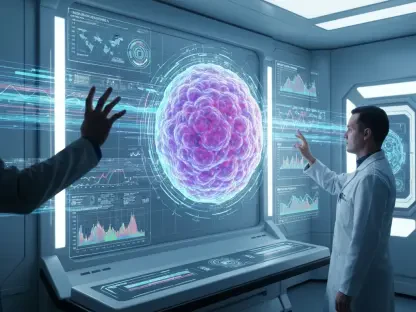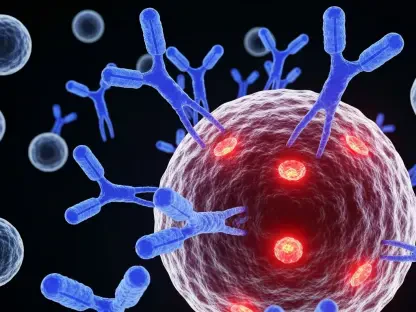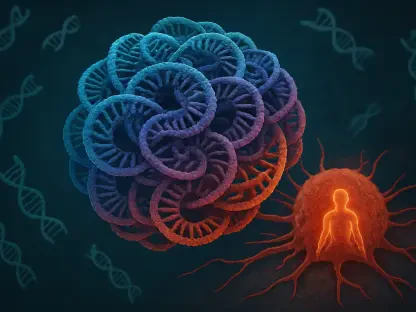Heart disease remains a leading cause of mortality worldwide, with heart failure accounting for 13 percent of global deaths. The inability of the human heart to regenerate lost muscle cells after birth has driven the exploration of cell-based therapies. Over the past two decades, significant strides have been made in developing these therapies, yet numerous challenges persist. This article delves into the progress, obstacles, and future directions of cell therapies for heart disease.
Historical Context of Heart Failure Therapies
Evolution of Current Treatments
The development of heart failure therapies has been a long and arduous journey. Treatments like implantable cardioverter-defibrillators and guideline-directed medical therapy took nearly four decades to optimize. These therapies, now essential in reducing mortality, faced initial skepticism and numerous hurdles. Importantly, the progression of these treatments highlights the time commitment, persistent research, and innovation needed to transform an experimental concept into a universally accepted clinical practice. As heart disease continues to claim countless lives annually, the journey and evolution of these treatments underline the necessity of perseverance and continuous advancement in the medical field.
The successes of established treatments like implantable cardioverter-defibrillators serve as an inspiration and a blueprint for emerging therapies. The medical community initially viewed these treatments with a degree of skepticism given the considerable investment of time and resources they demanded. Their eventual successes, however, illustrate the critical importance of remaining steadfast in the face of challenges. By reflecting on these historical breakthroughs, researchers and clinicians can better navigate the current landscape of cell-based therapies, leveraging knowledge gained from past developments to overcome key obstacles and innovate effectively in treating heart disease.
Initial Cell Therapy Strategies
Early cell therapy approaches aimed to replace dead cardiomyocyte heart muscle cells with new ones. Researchers focused on injecting replacement cells into scar tissue to rejuvenate muscle tissue. Despite the promise, these initial strategies encountered significant challenges, including cell survival and integration. The primary goal was to restore the functional capacity of the heart’s damaged regions—a formidable task given the complex biology of heart tissue and the hostile environment created by scar tissue. Since human heart muscle cells lose their ability to divide shortly after birth, researchers needed to devise ways to ensure the longevity and integration of transplanted cells within the patient’s heart.
Initial clinical trials highlighted multiple obstacles that needed addressing, ranging from immune rejection of transplanted cells to the difficulty of directing these cells to the exact locations within the heart needing repair. Moreover, ensuring that the new cells could thrive and establish connections with existing tissue posed further challenges. Despite these hurdles, early strategies provided a foundational understanding that guided subsequent research. The insight gained underscored the need for more innovative and robust methods for cell delivery, survival, and integration, leading scientists to refine their techniques and explore new cell types and mechanisms to achieve better outcomes.
Clinical Trials: Progress and Setbacks
Completed Clinical Trials
Over the past twenty years, numerous clinical trials have been conducted to test the efficacy of cell therapies for heart failure. While none have achieved full medical approval, many demonstrated safety and some beneficial effects. These trials provided valuable insights into the potential and limitations of cell-based treatments. The research helped to identify which cell types were most promising, how to optimize delivery methods, and how to address the body’s immune responses. Such trials, even when only partially successful, have significantly expanded our understanding of the complexities involved in cardiac cell therapy.
Results from these trials have shown that while clinical approval remains out of reach, safety profiles of certain cell therapies have proven acceptable. In many cases, researchers observed improvements in heart function and patient quality of life, albeit inconsistently. The trials underscored the necessity of more sophisticated approaches in crafting cell-based therapies. For example, knowing the extent to which injected cells could survive and integrate within the host tissue guided the focus for future research. Scientists thus turned their attention to improving cell survival rates, integrating engineered cell products, and tailoring therapies to harness the intrinsic repair mechanisms of the heart.
Lessons Learned
The failures and successes of past trials have informed current research directions. Key lessons include the importance of cell type selection, delivery methods, and the need for well-designed, adequately powered studies. These insights are shaping the design of ongoing and future trials. Researchers have learned that not all cells are equally effective for heart muscle regeneration; thus, current endeavors often involve pluripotent stem cell-derived cardiomyocytes or mesenchymal stem cells, which offer superior survival and reparative potential. The choice of delivery method—whether through intravenous injection, direct cardiac injection, or engineered patches—plays a crucial role in therapy outcomes.
The need for rigorously designed and sufficiently powered studies cannot be overstated, as underpowered trials have previously led to inconclusive results and extended patient vulnerability. This emphasis on robust study design ensures meaningful progress and addresses ethical concerns about patient safety and the appropriate use of funding and resources. As a result, researchers today are better positioned to conduct clinical trials that not only gauge safety and efficacy but also provide actionable data that refines future therapies. Innovating upon these pivotal lessons learned fosters a cycle of continuous improvement, driving each new trial closer to viable, widespread clinical use.
Innovative Approaches in Ongoing Research
New Cell Types
Recent trials are exploring the use of new cell types, such as pluripotent stem cell-derived cardiomyocytes/spheroids and umbilical cord-derived mesenchymal stem cells. These cells offer potential advantages in terms of survival, integration, and functional improvement. Pluripotent stem cells, in particular, possess the ability to differentiate into various cell types, offering versatility in regenerating heart tissue. Meanwhile, mesenchymal stem cells from umbilical cords present fewer ethical issues and are less likely to provoke immune rejection. Researchers are hopeful that these cell types will surpass the limitations encountered by earlier attempts, paving the way for more effective therapies.
Each new trial modifies its approach based on lessons from previous studies, fine-tuning the conditions under which these cells can thrive and contribute to heart repair. For instance, scientists now understand that the microenvironment into which cells are introduced plays a vital role in their survival and integration. As a result, recent strategies involve preconditioning cells or creating supportive matrices to enhance their efficacy. These sophisticated approaches aim to ensure that transplanted cells can withstand the hostile post-infarction environment, integrate seamlessly, and restore heart function more consistently than prior methods.
Noninvasive Delivery Methods
Innovative delivery methods, such as repeated intravenous injections, are being tested to improve the efficacy and safety of cell therapies. These noninvasive approaches aim to enhance cell distribution and reduce procedural risks. Intravenous delivery offers the potential to reach broader areas of the heart and other organs, making it a less restrictive and more versatile method of administration compared to direct cardiac injections. Repeated dosing through this route can help maintain therapeutic cell levels in the patient’s system over time, potentially improving long-term outcomes without the need for multiple invasive procedures.
Noninvasive techniques also alleviate some of the logistical and physiological challenges associated with traditional cell delivery methods. By reducing the need for surgical intervention, these approaches minimize patient recovery times, procedural complications, and healthcare costs. The ongoing development of tailored delivery systems aims to optimize the dispersion and activity of therapeutic cells, thereby maximizing their benefits. These advancements are a testament to the creativity and determination of researchers who continue to push the boundaries of what is possible in cardiac care, relentlessly striving to make cell therapy a practical and accessible treatment option for heart failure patients.
Development of New Cell Products
Engineered Cardiomyocyte Patches
Researchers are developing engineered epicardial cardiomyocyte patches as a novel cell product. These patches aim to provide structural support and functional improvement to damaged heart tissue, offering a new avenue for cardiac repair. Engineered patches are designed to mimic the natural architecture of healthy heart tissue, integrating seamlessly with the existing muscle to facilitate repair and regeneration. This approach holds the promise of circumventing some of the major hurdles associated with cell injection therapies, such as ensuring the cells stay in place and maintain their functional integrity within the harsh environment of damaged cardiac tissue.
Engineered patches can be pre-vascularized to improve their integration and survival once implanted, and they can be customized to fit the specific needs of individual patients. This personalized approach improves the chances of success and reduces the risk of immune rejection. Researchers are actively investigating the use of biocompatible scaffolds and biomaterials that can both support the cells and encourage the natural repair mechanisms of the heart. These patches represent a significant leap forward in the quest to create durable and effective treatments for heart disease, potentially transforming the way cardiac care is administered.
Cell-Free Products
Exploration of cell-free products, such as extracellular vesicle-enriched or exosome-enriched secretomes, is gaining traction. These products may offer therapeutic benefits without the complexities associated with cell transplantation. Extracellular vesicles and exosomes are small particles released by cells that carry proteins, lipids, and genetic material capable of modulating the behavior of recipient cells. These vesicles can be harvested from therapeutic cells and used to promote tissue repair and regeneration in a targeted and efficient manner. By harnessing the beneficial effects of these cell-derived products, researchers hope to achieve similar or even superior outcomes compared to cell-based therapies without the risk of immune rejection or integration failure.
One of the key advantages of cell-free products is their potential for scalable production and off-the-shelf availability, which could significantly lower the costs and barriers to widespread clinical use. They also offer a less invasive treatment option, as they can be delivered through standard medical procedures like injections or intravenous infusions. The ongoing research into the efficacy and mechanics of these cell-free therapies continues to garner attention and momentum, reflecting the field’s commitment to innovation and the exploration of all viable avenues for treating heart failure.
Addressing Criticism and Ensuring Future Success
Criticism and Funding Challenges
The field of cell therapy research has faced criticism, particularly regarding the use of public funds for trials with minimal improvements in cardiac function. Addressing these concerns requires well-funded, rigorously designed studies to ensure meaningful progress. Critics argue that some studies were poorly designed or lacked the statistical power to produce conclusive results, thus failing to justify the substantial investments made. This skepticism underscores the importance of transparency, accountability, and rigorous evaluation in the research process to rebuild trust and secure funding for future endeavors.
To counteract these criticisms, researchers must prioritize the development of robust protocols that maximize the potential for meaningful findings. This includes comprehensive preclinical testing, careful patient selection, and the use of advanced technologies to monitor and measure treatment outcomes accurately. By demonstrating the scientific rigor and practical relevance of their work, researchers can build a compelling case for continued support from both public and private funding sources. The success of future trials hinges on this commitment to excellence and the sustained belief in the potential of cell therapies to revolutionize heart disease treatment.
Importance of Rigorous Design
Future trials must be meticulously planned and executed to build on past experiences. Adequate funding, robust design, and sufficient power are essential to advancing the field and achieving clinical translation. A well-structured trial design includes comprehensive risk assessment, the use of control groups, and standardized outcome measures to ensure validity and reliability. Researchers should strive to anticipate and mitigate potential challenges such as patient variability and treatment complexities to improve the likelihood of achieving significant and reproducible results.
Collaboration among interdisciplinary teams can enhance the design and execution of these trials by integrating diverse expertise and perspectives. Engaging with regulatory bodies, patient advocacy groups, and other stakeholders can also provide valuable insights and support, aiding in the refinement of trial protocols and the alignment of research goals with patient needs. As the field of cell therapy research continues to evolve, adherence to rigorous scientific principles and an unwavering commitment to excellence will be critical in transforming experimental treatments into mainstream clinical practice.
The Road Ahead for Cell Therapies
Embracing Novel Techniques
The ongoing evolution of cell therapy research reflects a commitment to innovation. By embracing novel techniques and learning from past experiences, researchers aim to develop effective treatments for heart failure. Revolutionary advancements, such as the use of gene editing tools, biomaterials, and personalized medicine approaches, have the potential to significantly enhance the efficacy and safety of cell-based therapies. Combining these cutting-edge technologies with traditional methods could lead to breakthroughs that were previously thought impossible.
Researchers remain vigilant in their pursuit of knowledge, continually testing new hypotheses and refining their strategies. This relentless drive for innovation ensures that the field remains dynamic and adaptable, capable of responding to emerging challenges and seizing new opportunities. By fostering a culture of experimentation and openness to novel ideas, the cell therapy research community can propel the development of groundbreaking treatments that offer hope to millions of heart failure patients worldwide.
Optimism and Perseverance
Heart disease continues to be a predominant cause of death globally, with heart failure contributing to 13 percent of deaths worldwide. The inability of the human heart to regenerate damaged muscle cells after birth has fueled the search for cell-based therapies as a potential solution. Over the past twenty years, significant progress has been made in the development of these therapies, showing promise in their ability to repair and regenerate heart tissue. However, many hurdles still need to be overcome before these treatments can become widely available and effective. This article explores the advancements, ongoing challenges, and potential future directions of cell-based therapies for treating heart disease, shedding light on the scientific endeavors and clinical applications that aim to reduce the burden of this condition. By examining the current landscape, we gain insight into how far we’ve come and what remains to be tackled to make these therapies a viable option for patients suffering from heart disease.









